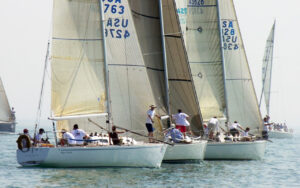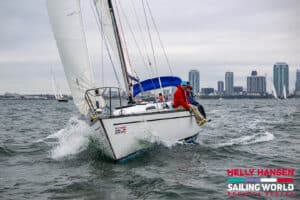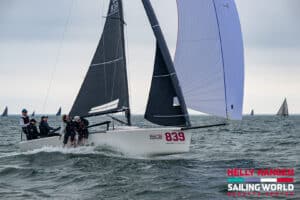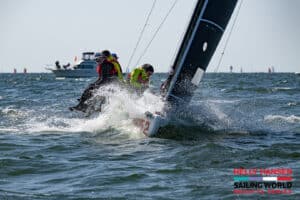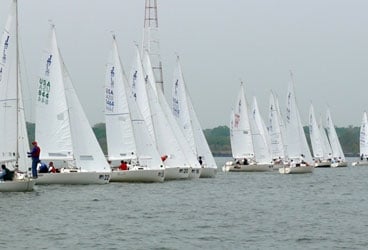
AnnapNOOD368
Annapolis, Annapolis, Annapolis. Those who have spent time sailing here know the Chesapeake’s fickle personality, especially in the spring after big rains. It’s all about current and light air, and the first day of the 2008 Sperry Top-Sider Annapolis NOOD was no exception. The outbound current prevented most sailors from being over early, except in the big fleets, but the current also gave skippers fits when it came to tactics and weather mark roundings.
Paul Murphy is sailing aboard Bat IV, a J/105 owned by Andrew Kennedy. “It was better than it could have been, at least it was smooth water so you could sail along reasonably,” said Murphy. “On Course 3, Melges and 105s, you’d go left to stay out of the current, then we saw some right-hand shifts, which made the right work. Sometimes even the locals don’t know which way to go, you would never go that way, but then someone does, and in a big fleet that works, so it was tedious sailing, a lot of pileups at the marks, but it was good light-air racing. We got hammered. But our owner’s in the hospital with shingles in his eyeballs, so we’re hoping things get better when he gets back aboard. There was some modest current in the beginning of the day, but a strong two knots by the end. The sky didn’t change too much, but there was a big right-hand shift in the second race, but I sure didn’t see it and there where no big indicators, but it did happen, it’s just part of racing in light air, so we just deal with it. Our driver was Reg Gardener, who just graduated from SUNY, and he did a nice job.”
Murphy is trimming mainsheet and, as he describes it, pondering during the racing. “We had nice starts, but we just weren’t going real well. Tomorrow we’ll just keep sailing. The rig was a little tight, but not bad, so we’re a little perplexed as to how we ended up so poorly. The top guys sailed pretty well, but with that adverse current in a big fleet, it’s easy to get stuck behind.”
Phil Eval is sailing with Brinksmanship, skippered by C.B Currier. Eval trims jib, calls tacks, and tries to “keep general sanity.”
“We had a moderately good day,” says Eval, “we had a few meltdowns, C.B. and I have just moved from an Alberg 30 to this boat, it’s different, but the Alberg 30 is a pretty competitive class and we had a lot of fun. I’ll say this for posterity, I’d rather sail an Alberg 30 than a J/30 any day, and I’ve sailed them both, the Alberg is actually a pretty fun boat to sail, and we still have the Alberg, and we’ll race it a little bit, but Currier wanted to get into something a little more high performance. We’ve got one of the oldest Melges 24s in the fleet, it’s number 30, and it was built in the first year the boat was being built. I love the Melges, I started sailing them when they first came out. What’s interesting is the learning curve in the boats. We did really well back in 1996, then I got out of the class, and these guys have gotten much hotter; much better.”
As far as tomorrow’s plan, Eval needed some inspiration. “After a few more rums we’ll figure that out.” We asked Eval what was the biggest challenge today, the current or the light air? “The learning curve, and the light air certainly, but really the learning curve for the Currier. There are a lot of pros in this class, and I’m not trying to be cocky at all, but there were some real good guys behind is a couple of times, and we were saying what are those guys doing back there? I’m looking at these pros, and C.B.’s no slouch as a sailor, but I’m looking at these guys. At the end of the day, in one-design racing, it’s one or two little meltdowns that happen during the race and you can’t get that back. We’re still working through the basics.”
Chuck Allen is sailing in the J/24 class with Will Wells. “We had a good, solid second, a deep finish, and a first,” said Allen. “Once the current switched after 9:30, 10 o’clock, coming from the NE, the bridge direction, it was all about getting to the right side, but that was only in the beginning of the race, around 11 o’clock, after that it was all left, all the time, and if you didn’t get there it was all over. There was a lot of current at the weather mark, and a lot of boats didn’t make it, and had to tack two or three times in no breeze; it was terrible, challenging. We were hoping to get four races in, but we only got three.”
“After winning the St. Pete NOOD overall,” said Allen, “we had to come all the way up here, we shipped all our boats up here, regatta and we’re here, and it’s beautiful. We were the first boat into the dock, and that’s always sweet.”

